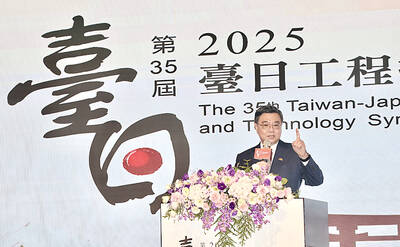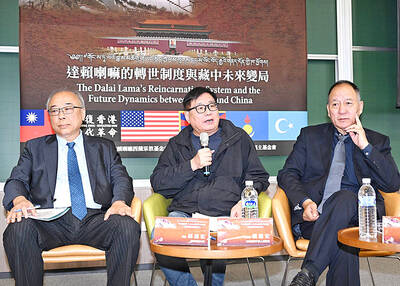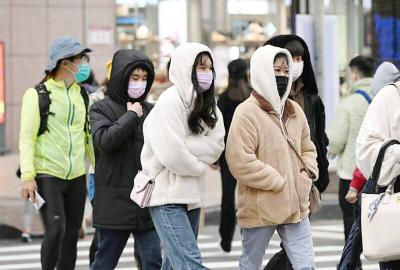The Taipei-Shanghai forum being held in Taipei this week is an information-gathering exercise for Beijing to benefit its cross-strait policy, said Kou Chien-wen (寇健文), a professor of political science at National Chengchi University’s Graduate Institute of East Asian Studies.
Sha Hailin (沙海林), director of the Shanghai Municipal Committee United Front Work Department and the first high-ranking Chinese official to visit Taiwan since President Tsai Ing-wen (蔡英文) assumed office on May 20, arrived in Taipei on Monday to attend a forum on Tuesday.
Beijing has applied pressure on the Tsai administration since it took office by cooling cross-strait exchanges and shutting the various communications links established by former president Ma Ying-jeou (馬英九) to isolate Taiwan, Kou said in an interview with the Chinese-language Liberty Times (sister paper of the Taipei Times).

Photo: Huang Yao-cheng, Taipei Times
To date, Beijing has cut the “first track” channel between the Mainland Affairs Council and it’s Taiwan Affairs Office, and the “second track” between the Straits Exchange Foundation and China’s Association for Relation Across the Taiwan Straits.
Beijing has also placed a virtual freeze on interactions between privately owned think tanks, he said.
Beijing has also moved to dampen informal cross-strait exchanges by limiting the number of Chinese tourists and students to Taiwan, playing up the recent bus fire accident in Taiwan that killed 24 Chinese tourists, encouraging talk that Taiwanese are unfriendly toward Chinese and forbidding Taiwan-related advertisements in Chinese media, Kou said.
However, withholding official exchanges over a long period has proved to be “a double-edged sword,” because Beijing has in the past depended on information gleaned from China’s exchanges with senior officials in the former Chinese Nationalist Party (KMT) government, academics and journalists to make or fine-tune its policy, information that became unavailable with the self-imposed freeze in exchanges, he said.
Although Beijing could still count on pan-blue leaders to supply information, their intelligence on Taiwan affairs tends to be “one-sided and of dubious veracity,” Kou said.
“From the Chinese perspective, a continuation of the intercity forum meetings offers many potential benefits,” he said, adding that as long as the forum is packaged as a “municipal exchange,” Beijing has the opportunity to accomplish three major goals important to its cross-strait policy.
First, Beijing sees the forum as a “reward” to Taipei Mayor Ko Wen-je (柯文哲) for making remarks ingratiating to China, such as his comment that “the peoples across the Strait belong to the same family” and his “respect” for the so-called “1992 consensus” — a purported tacit understanding reached during cross-strait talks in 1992 that both Taiwan and China acknowledge that there is “one China,” with each side having its own interpretation of what that means. Former Mainland Affairs Council chairman Su Chi (蘇起) has admitted to making up the term in 2000.
“By setting Ko as a good example, Beijing is hinting to the Tsai administration that they can achieve good relations with China by taking baby steps,” Kou said.
Second, Sha could invite nominal observers and researchers to Taiwan to engage in social networking, yet without suggesting that cross-strait relations have improved and lessening pressure on Tsai, he said.
“Ko’s unanticipated success as a non-mainstream party candidate has turned him into the biggest potential adversary of the DPP in the next election. Ko has no party baggage and is relatively receptive of the ‘1992 consensus,’ so Beijing’s calculation is to ‘ally with the secondary enemy to attack the primary enemy,’” Kou said.
Beijing is concerned about the viability of the KMT as a political entity after its landslide election losses this year, Kou said, adding that the proof is in Sha’s meeting yesterday with New Taipei City Mayor Eric Chu (朱立倫).
Third, the forum allows China’s high-level officials to engage their counterparts in dialogue, without contradicting the official story of icy cross-strait relations that Beijing worked hard to maintain, Kou said, adding that the forum is the only realistic window China has with Taiwan after communications on the first track and the second track.
The fact that Beijing sent Sha to the forum — a Chinese Communist Party (CCP) Municipal Standing Committee member and a United Front Work director whose credentials overshadow the nominal star of the delegation, Shanghai Mayor Yang Xiong (楊雄) — is a move that allows Beijing to engage in dialogue without changing its posture, Kou said.
Though Beijing is maintaining its cold-shoulder policy toward the Tsai administration, important regional events scheduled later this year, such as the International Civil Aviation Organization (ICAO) and APEC meetings, would make interaction unavoidable; as such, Sha’s attendance at the forum in Taipei could give Beijing an unofficial go-between to smooth things over with Taiwan before later events, he added.
“In the sense that this forum does not affect Beijing’s posturing or cause Tsai any embarrassment, going ahead with the forum is a pragmatic move,” Kou said.
In the forum, Ko should focus on being the “bridge” between Tsai and Beijing and not leverage his role against the DPP for greater influence, because Ko’s support ratings have been declining in the polls, while Tsai’s support remains comparatively strong, Kou said.
According to Kou, although Beijing has said Tsai has given it an “incomplete test paper” on cross-strait relations and has neglected to give answers, Beijing has not completed its evaluation of Tsai’s administration, which is pending until the CCP’s National Congress in autumn next year, giving both sides “ample time” to deal with the situation.
However, the congress will result in significant changes in the CCP hierarchy and if Beijing does not find Tsai’s responses to its liking, it is a certainty that Chinese President Xi Jinping (習近平) will take action to forestall the Taiwan issue from becoming a political weapon that his adversaries could use against him or his faction, Kou said.

ALIGNED THINKING: Taiwan and Japan have a mutual interest in trade, culture and engineering, and can work together for stability, Cho Jung-tai said Taiwan and Japan are two like-minded countries willing to work together to form a “safety barrier” in the Indo-Pacific region, Premier Cho Jung-tai (卓榮泰) yesterday said at the opening ceremony of the 35th Taiwan-Japan Modern Engineering and Technology Symposium in Taipei. Taiwan and Japan are close geographically and closer emotionally, he added. Citing the overflowing of a barrier lake in the Mataian River (馬太鞍溪) in September, Cho said the submersible water level sensors given by Japan during the disaster helped Taiwan monitor the lake’s water levels more accurately. Japan also provided a lot of vaccines early in the outbreak of the COVID-19 pandemic,

Kaohsiung Mayor Chen Chi-mai (陳其邁) on Monday announced light shows and themed traffic lights to welcome fans of South Korean pop group Twice to the port city. The group is to play Kaohsiung on Saturday as part of its “This Is For” world tour. It would be the group’s first performance in Taiwan since its debut 10 years ago. The all-female group consists of five South Koreans, three Japanese and Tainan’s Chou Tzu-yu (周子瑜), the first Taiwan-born and raised member of a South Korean girl group. To promote the group’s arrival, the city has been holding a series of events, including a pop-up

TEMPORAL/SPIRITUAL: Beijing’s claim that the next Buddhist leader must come from China is a heavy-handed political maneuver that will fall flat-faced, experts said China’s requirement that the Dalai Lama’s reincarnation to be born in China and approved by Beijing has drawn criticism, with experts at a forum in Taipei yesterday saying that if Beijing were to put forth its own Dalai Lama, the person would not be recognized by the Tibetan Buddhist community. The experts made a remarks at the two-day forum hosted by the Tibet Religious Foundation of His Holiness the Dalai Lama titled: “The Snow Land Forum: Finding Common Ground on Tibet.” China says it has the right to determine the Dalai Lama’s reincarnation, as it claims sovereignty over Tibet since ancient times,

Temperatures in some parts of Taiwan are expected to fall sharply to lows of 15°C later this week as seasonal northeasterly winds strengthen, the Central Weather Administration (CWA) said today. It is to be the strongest cold wave to affect northern Taiwan this autumn, while Chiayi County in the southwest and some parts of central Taiwan are likely to also see lower temperatures due to radiational cooling, which occurs under conditions of clear skies, light winds and dry weather, the CWA said. Across Taiwan, temperatures are to fall gradually this week, dropping to 15°C to 16°C in the early hours of Wednesday